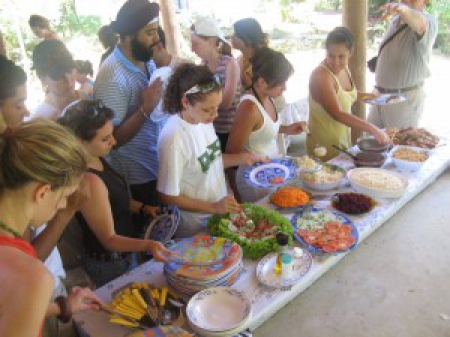Saco de Mamanguá and Joatinga
概览
History of this Location
The handicraft business of the Indians of Saco do Mamanguá dates back about four decades to the formative years of a pair of brothers, João and Pedro Souza. As kids the Souza brothers constructed toy boats for their own diversion. Today about half of the 100-plus families that inhabit the Saco do Mamanguá owe their livelihoods to the miniature boats built in the Souza tradition and sold, mostly to tourists, in Paraty. The artisans collect their raw material from just beyond the swamp - at the closed end of the fjord. There grow the caxeta trees, called Ambay pulpwood in English. Artisans cut tree branches and, to avoid carrying out excess weight, they carve out crude sections on the spot. Back in their workshops, they whittle down and smoke the waterlogged lumber before sanding and finishing. The brothers and many of their immediate followers left the wood bare. But most of today’s artisans prefer to paint their boats in striking colors that resemble those adorning the small fishing boats that still frequent the coast astride Paraty. Thanks in part to this new twist, the local artisans netted an exposition in the federal government’s Edison Carneiro Folklore Museum in Rio de Janeiro last year. The Saco do Mamanguá sits pretty close to Larangeiras, a closed condominium whose part-time residents include many of Brazil’s most rich and famous. Without roadways, and there are none, the proximity never made much difference. Take the long way by boat; take the shortcut by foot. The Saco do Mamanguá was essentially protected because it was hard to get to. This was until some of the Larangeiras crew bought up enough right-of-way and a piece of land at the end of the fjord. Their idea was to construct a marina and build an access road to it from their luxury accommodations.
Sustainable Features
Biologist Paulo Nogara and his wife have been working with the local community for over a decade. They are concerned about the increased boat traffic which would create wave problems for the local fishermen; the sediment from the floor would be suspended in the water and create problems for photosynthesis and oil from boats would either end up at the end of the fjord or at the ocean bottom. After a highly publicized campaign, marina opponents managed to stall the project. For now the scheme is tangled up in the Brazilian legal bureaucracy, but the threat remains. While many locals are opposed to the project, a few actually favor it. Many of these are uneducated and underemployed people who understandably hope for unskilled jobs pumping gas or guarding yachts. One alternative would be to encourage ecotourism. Kayaking tours, excursions up small mountains lining the fjord, and hiking treks offer views otherwise only possible from a helicopter. The energetic can trek to Paraty, several hours by foot, or take shorter trips along the routes used by locals for decades, if not centuries.
Location Information
(24) 3371-1951
contato@sacodomamangua.com
http://www.sacodomamangua.com
Location:
评论
Connections
- Paraty
- Brooklyn美国
- 台湾
- 中国香港特别行政区
- 台南市台湾
- Cesky Krumlov捷克
- London
- Montclair美国
- Detroit美国
- Near Alloa英国
- San Francisco美国
- 台南市台湾
- 美国
- Yogyakarta印度尼西亚
- 阿根廷
-
- Montclair美国
-
- Ocracoke美国
- Al Ain阿拉伯联合酋长国
- Hatteras美国
- Sarasota美国
- New York美国
- Sarasota美国
- 阿根廷
- 美国
Multimedia

Saco de Mamanguá and Joatinga

Impacts
No impacts have been left for this site yet - be the first!







